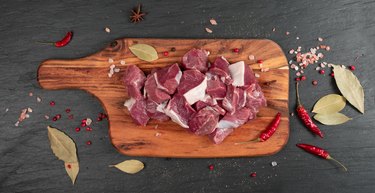
If you enjoy straying from the typical chicken and beef meals from time to time, lamb recipes may offer a tasty, flavorful option. Cubed lamb is a versatile dish you can eat in a variety of ways, whether in a lamb stew or salad or served with vegetables and rice.
When cooking lamb pieces, shop for firm, red cuts with a smooth, velvety texture, says Michigan State University Extension (MSU). Cuts with small flecks of fat in the meat, aka marbling, will be the most tender and flavorful.
Video of the Day
Video of the Day
Your method of cooking will also dictate the flavor profile of lamb. Cooking lamb chunks in the oven may give you a different outcome than a lamb stew, for example. Your recipe will dictate how to prepare your cubed lamb.
Looking at Lamb Nutrition
According to the USDA, 1 ounce of leg of lamb contains 65 calories, 5.1 grams of protein, 0 grams of carbohydrates and 4.8 grams of fat, including 2.1 grams of saturated fat. It's high in potassium and has 30 percent of the daily value for vitamin B12.
The Ohio State University Wexner Medical Center notes that diets high in red meat, like lamb and beef, have been linked to an increased risk of colorectal cancer. According to a February 2015 study in Oncology Reviews, there's evidence that red meat consumption, including lamb, increases colorectal cancer risk by 20 to 30 percent.
The 2015-2020 Dietary Guidelines for Americans also recommend avoiding saturated fats. A diet high in saturated fats may increase levels of "bad" low-density lipoprotein cholesterol, potentially compromising heart health, says Harvard Health Publishing.
Given the nutrition profile of lamb, you may wish to eat it only occasionally. The Dietary Guidelines advise eating a variety of protein foods, like poultry and seafood — plus plenty of fruits, vegetables, whole grains and fat-free or low-fat dairy.
Read more: Is Lamb Meat Healthy?
Cooking Lamb Pieces
To ensure you have a safe, mouth-watering culinary experience with lamb, MSU recommends the following tips:
- For safe meat handling, store raw lamb in a bowl on the bottom shelf of the refrigerator. The same is true of lamb you are thawing from frozen. Cook or freeze lamb within three to five days of purchase.
- Use separate utensils, cutting boards and platters for raw and cooked lamb. Wash all items that have come in contact with raw lamb, using hot, soapy water.
- Soak the lamb in marinade if you wish — again, in the refrigerator. If you want to use some of the marinade as dressing for your cooked lamb, set some aside before adding it to the raw meat. Discard any unused marinade that has come in contact with raw meat.
- Cook lamb chops, roasts and legs to an internal temperature of 145 degrees Fahrenheit, says the Centers for Disease Control and Prevention. Ground meat should reach 160 F. Use a digital thermometer to check the temperature.
- Let the meat rest for three minutes before carving.
- Consume cooked lamb within three to four days of cooking, or freeze it for up to three months.
Note that dry-heat methods like broiling, baking, grilling, roasting and pan frying are ideal for more tender cuts of lamb, says MSU. Moist-heat methods like braising or cooking with liquid, as you might use when cooking lamb stew, work best for less tender cuts of lamb.
When cooking lamb pieces, consider the cut of meat as you select a recipe. Lamb stew may involve different methods than a recipe that calls for lamb chunks in the oven, for example. MSU suggests the following methods for different cuts.
Braising and moist-heat cooking:
- Stew meat chunks, such as cubed lamb
- Lamb shanks
Roasting and dry-heat cooking:
- Lamb leg, bone in or boneless
- Shoulder roast, bone in
- Lamb crown rib roast or rack of lamb
- Lamb chops, ribs or loin
- Ground lamb
Some recipes may call for a combination of methods, such as searing lamb on the stovetop and finishing off the lamb chunks in the oven.
This LIVESTRONG.com recipe for Cape Malay Lamb Curry is a stovetop method with both savory and sweet flavors. Try it on a weekend evening when you have a couple hours to spend in the kitchen.
- USDA: "Nutrition Facts for Leg of Lamb"
- Health.gov: "Dietary Guidelines for Americans, 2015-2020: Chapter 1. Key Elements of Healthy Eating Patterns"
- Ohio State University Wexner Medical Center: "What Are the Healthiest Animal Protein Sources?"
- Oncology Reviews: "Red Meat and Colorectal Cancer"
- Harvard Health Publishing: "The Truth About Fats: The Good, the Bad and the In-Between"
- Centers for Disease Control and Prevention: "How to Grill Safely"
- Michigan State University Extension: "Handling, Using & Storing Lamb"